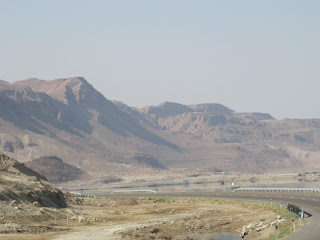Yesh is not just the Israeli way of saying an emphatic Yes!, nor is it only the local grocery store called Yesh in most Israeli towns.(see sign below)
We are nearly finished counting the days between Pesach and Shavuos otherwise known as Sefiros HaOmer. It is a period of self examination of ourselves as we once again receive the Torah on the holiday of Shavuos.We not only commemorate how Hashem in His great chesed for us, freed us from Egypt , but also we realized He pulled us from the depths of the depths of Mitzrayim,(Egypt) the lowest of all spritual places. We had to earn our way up from the 49th level of tumah (spritual impurity) to deserve Matan Torah (receiving the gift of the Torah)
We are nearly finished counting the days between Pesach and Shavuos otherwise known as Sefiros HaOmer. It is a period of self examination of ourselves as we once again receive the Torah on the holiday of Shavuos.We not only commemorate how Hashem in His great chesed for us, freed us from Egypt , but also we realized He pulled us from the depths of the depths of Mitzrayim,(Egypt) the lowest of all spritual places. We had to earn our way up from the 49th level of tumah (spritual impurity) to deserve Matan Torah (receiving the gift of the Torah)
Sefiros HaOmer is the tikkun of the peh- the mouth. We count with our lips. All-of our avoda, tefilla, speech and thoughts are elevated . The goal of the jew at this time is to watch carefully what we say and we try to speak to each other with more respect, kindness and care. We daven with greater kavanah and we make brachos with more devotion.
The gematria of omer =10= the gematria of yesh
The roshei tevos(first letter of each word) of "yesh" are the same as "yiras shamyim"
We know from our sages of blessed memory, that Hashem created the world "Yesh May Ayin".
Something from nothing. This Light, or revelation of Hashem ,was in existence before He "measured "out His infinite light to create midos. Our world was created with this very powerful light , filtered many times because it was too strong and powerful for finite creatures like humans to handle.
According to the Beis Aaron, we are meant to do the reverse: to take "yesh" and make into "ayin". We are to bring what Hashem gave us and give it back to the Source of all life. During Sefiros HaOmer we work on tikkun ha middos, "correcting, and fixing" our character traits that Hashem has given us. He distinguished us from animals by giving us the gift of speech. Humans in hebrew are called "medaber"; the one who speaks.
"Yesh" is the omer because our avoda is to take the yesh, the gashmi, the physical of the world and elevate it back to Hashem with more pure speech. It is our helek in olam Haba.





















